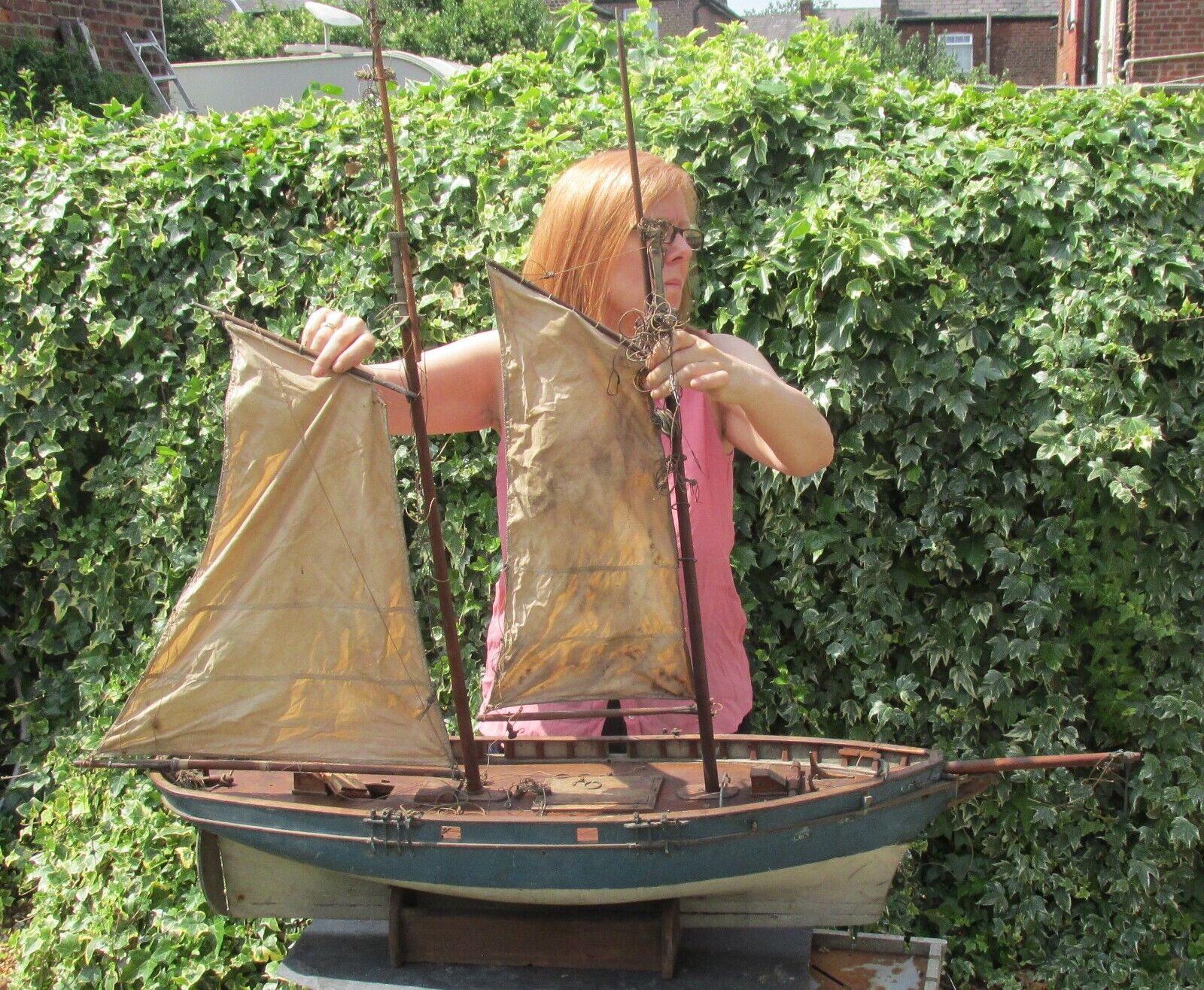
Orere (Daring) trenail built pond yacht c1863 New Zealand schooner 1/20th boat For Sale
 When you click on links to various merchants on this site and make a purchase, this can result in this site earning a commission. Affiliate programs and affiliations include, but are not limited to, the eBay Partner Network.
When you click on links to various merchants on this site and make a purchase, this can result in this site earning a commission. Affiliate programs and affiliations include, but are not limited to, the eBay Partner Network.
Orere (Daring) trenail built pond yacht c1863 New Zealand schooner 1/20th boat:
$43968.75
This came from an estate sale together with another interesting historic boat (pond yacht) from New Zealand - (please see the response below). A period 1837 Brig - Victoria. The present boat is a 38 by 10 inch pond yacht (length without foremast); twin masted topsail schooner. c1860-70. A match-stick tin (Bryant & May) with printed gilded chinese design has small parts in it and a date of 1870 impressed into the lid and was found with the boat. (The tin itself quite a rare item) Rather amazingly the boat is held together largely with trenails; some of which are only a few millimeters in diameter. (they can only be seen because they have somewhat loosened and raised over time due to daily differential expansion and contraction of the differently grained wood over time) (a piece of the wood (a white stick) used to make the trenails was inside the hull. I did not realise what it was at first, thinking that the raised heads of trenails were pins - only realising that they were trenails some-time later - so I used it to make some pen marks so as to measure the depth of the hull. It is white in colour and has parenchyma like bamboo, - I wonder if it is a native species to New zealand, used because the parenchyma resist water ingress whilst the wood of the hull around them expands to tighten them when wet?.PerhapsSporadanthus ferrugineus, a bog dweller and therefore waterproof.I have teased apart the forward hatch/companion way (as shown above) to show that its construction is finely carved and jointed and kept together with trenails. (One can compare this with the similar construction of the remains of the companion way on full size contemporary boats such as Daring (see below)).The hull is carved from one piece of finely grained solid wood, which I think is Kauri from its aged reddish brown appearance on the carved inside of the hull. Of interest is that it is still water-tight and floats. (so one could restore it to actually see what she was like under sail). One can compare this with similarly carved Mauri artifacts. It might be possible to date the boat exactly from the closely spaced tree rings in the hull, their narrow spacing running downward as shown of the view inside the hull.. One might compare it directly with wood from Daring. (the rings on Daring, are visible on images shown on-line) (read on). All of the boat's parts are hand-made - forged in the case of the anchor and striker on the bowsprit. The holes in the striker for rigging are even punched out (pierced) rather than drilled - as would have been the original - so that the metal retains its strength when loaded. Which is just as important to a model as it is to the real boat. Of particular relevance is that relatively recently, the wreck of the schooner 'Daring' - wrecked in 1863 on a beach on the west of North Island was discovered, uncovered by shifting sands. The boat looks exactly like the present pond yacht, (note especially the carved windlass/winch), apart from the stern - which is slightly more rounded on the present boat. If the scale of the present boat is 1/20th, it's dimensions are exactly the same as Daring. Although it uses other woods, it is carved from a significantly large piece of wood, perhaps as large as the timbers used on Daring herself.The finely chiselled name board on the stern is Orere - which is a township - first established as a missionary, and which is about 40 miles west from where Daring was wrecked and bout 50-60 miles south from where she was built in Mangawhai. Such schooners played an important role in access and transport in the absence of roads. I can find one entry in the New Zealand Maritime Museum, reference from a newspaper in 1900 reporting that 'Orere' was delayed by a storm, so the boat undoubtedly existed and the evidence from the present model suggests she was contemporary with Daring...even using similar methods of construction. Kauri was popular because of the large size pieces of finely grained wood, which was easy to work and carve, and the wood was unaffected by prolonged immersion in water. The existence of the wreck and the present finely carved pond yacht is testament to its longevity. Generally in good condition for its 150 years, the lead keel weight is sagging a little with age, so that light can just be seen between it and the hull between attachment points. The rudder arm is broken from the rudder post. Most of the rig and original sails still appear to be in tact. (I have laid them out incorrectly on the grass - as the large sail should be at the stern.) the winch is missing it's supports. It is of interest that the present boat has gun-ports, as most ships of the time were expected to be used against Mauri insurrection, again adding to the historicity of the present boat...I wondered if lessons could be learned from the construction of the present boat, which might inform the restoration of Daring - which is having a multi-million dollar museum built around it. Especially given that it is more complete than Daring herself and importantly still has most of her rig, including her sails. I think that there is probably no knowledge of Daring's rig. There is enough of a likeness between this pond yacht, in terms of scale, and Daring to suggest the two boats have essentially the same sail layout..The only extant period image of Daring is a child's distant drawing which lacks sails and also gun ports. The exact scale and use of trenails suggests that this may well have been built by a master boat builder. This came from an estate sale , and the chances of such a pond yacht existing, let alone finding it, are probably much less than the accidental finding of Daring herself, as there were many such boats of her type. And probably more will be discovered in the future. Daring proves that Kauri can resist the elements. However to find an individual who could carve such fine, functional scale detail, or who had the motivation and knowledge of boat building, to reproduce on this pond yacht, which itself was not a necessity in 1870 - unlike Daring and the numerous boats of her type, the chance is so small to almost be beyond imagination. Making this pond yacht a once in a lifetime occurrence.Moreover, the model physically is complete enough with small adjustments to the rig, to actually demonstrate how Daring functioned, moreso than the wreck herself. On these grounds, one might justifiably believe that the present boat should itself have its' own museum. A kind of maritime 'Holy grail'. Maybe almost a religious artifact or Icon.(upon reflection, given the extreme lengths that the boats builder has gone to incorporate functional detail in the present boat - I wonder if the hull is carved rather than planked - because Kauri didn't or doesn't make good thin planks, especially with the tools then available, but is easily carved - and perhaps there was no suitable alternative) (moreover the hull profile might have been a compromise for suitable ballast (in the form of a long deep lead keel) in order to allow the boat to sail effectively with it's particular rig, likewise the stern might be tailored to suit the particular piece of wood it was carved from (it does show evidence of splitting at the stern which might have been more of a problem with a true to life profile) All this functionality derived from the experience of the boat's builder. I am guessing, indeed, that the gunwale is made from a different wood,- evident by knots in it which are not present in the hull (Kauri has few knots, especially from large sections of timber [and this lack of knots is evidenced inside the hull, as shown above])...suggesting that the hull material was not suitable for making planks. (either innately of because it could not be cut finely with the tools then available). Noting that since this was first listed, a model of Daring has been made using detailed research and computer generated design. In the process - special tools were used/required - including tools with tungsten tipped edges. Rather indicating that these were needed to cut thin timbers of Kauri.... Suggesting, indeed, that a contemporary model of Daring could not have been built from Kauri planks.. Moreover, that model needs the addition of a separate keel to sail under certain conditions. Whereas one feels that the builder on the present model has compromised detail of the form and ballast for functionality. An amazing synthesis of original scale design, build detail, construction and methods with function as a working boat at scale size. Just needs a 1/20th size crew. One day, not far off, that might be possible, if it's not already in some reseach lab.
Please note in the EU that this can only be purchased through an agent in the UK as we are not VAT registered in individual countries in the EU. so please do not press the Buy It Now as monies will be taken directly from your bank account.

![]()
Blog Posts
- Day Trippin' to Southern Colorado Backcountry Streams
Despite flirting with the Big River earlier this summer when I think about fishing in Southern Colorado, I think about backcountry small streams... - Baja Adventures
Aloha, had a great time down in Baja. Some are saying the sun is setting on the fishing in baja... - Back in Southern Colorado
For more than 45 of my 60+ years, I have spent part of my summer in the Southern Rockies... - Why We Fish
In science, some concepts and ideas are so complex or abstract that they defy definition. In order to proceed and communicate...